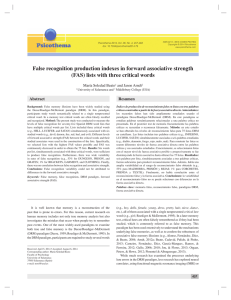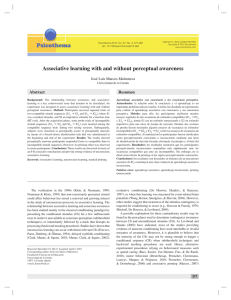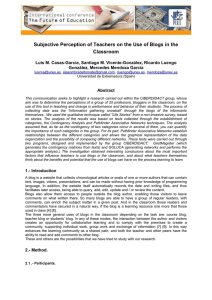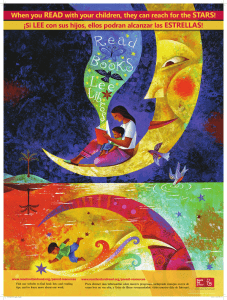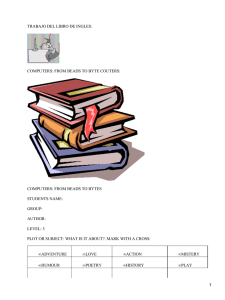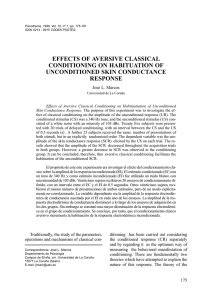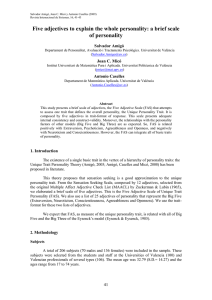-Cadavid (def)
Anuncio
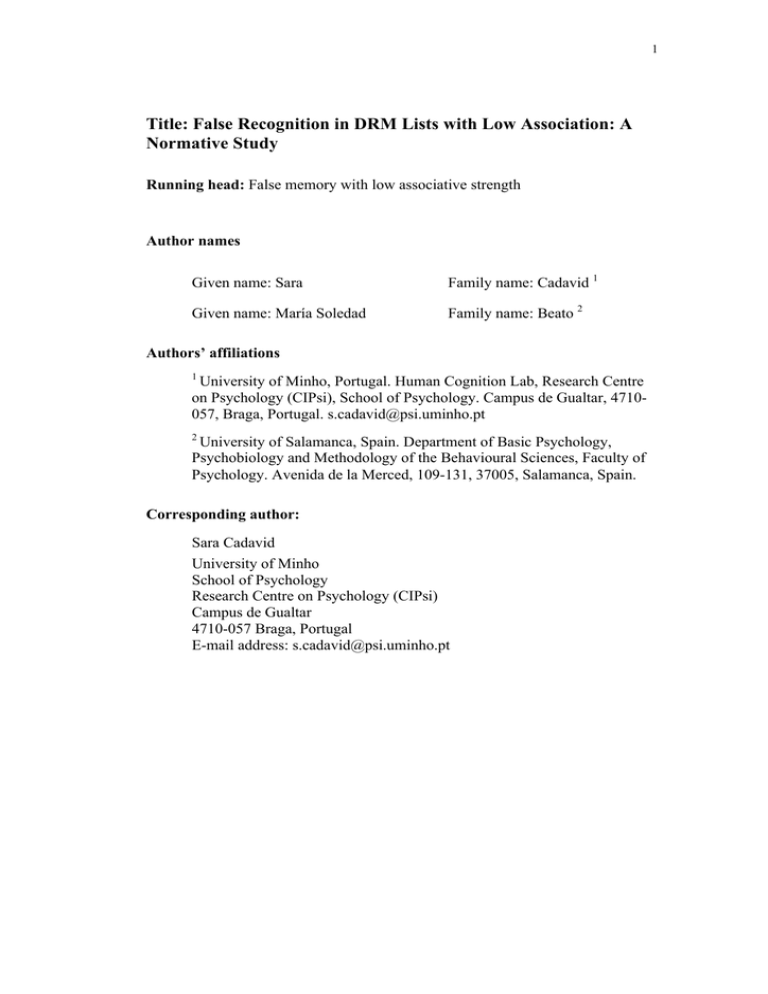
1 Title: False Recognition in DRM Lists with Low Association: A Normative Study Running head: False memory with low associative strength Author names Given name: Sara Family name: Cadavid 1 Given name: María Soledad Family name: Beato 2 Authors’ affiliations 1 University of Minho, Portugal. Human Cognition Lab, Research Centre on Psychology (CIPsi), School of Psychology. Campus de Gualtar, 4710057, Braga, Portugal. s.cadavid@psi.uminho.pt 2 University of Salamanca, Spain. Department of Basic Psychology, Psychobiology and Methodology of the Behavioural Sciences, Faculty of Psychology. Avenida de la Merced, 109-131, 37005, Salamanca, Spain. Corresponding author: Sara Cadavid University of Minho School of Psychology Research Centre on Psychology (CIPsi) Campus de Gualtar 4710-057 Braga, Portugal E-mail address: s.cadavid@psi.uminho.pt 2 Abstract A wide array of studies have explored memory distortions with the Deese/Roediger-McDermott (DRM) paradigm, where participants study lists of words (e.g., door, glass, pane, shade, ledge, etc.) that are associated to another nonpresented critical word (e.g., WINDOW). On a subsequent memory test, the critical word is often falsely recalled and recognized, even though the critical word was not studied. The present normative study provided false recognition indexes for 48 DRM lists in Spanish with three critical words per list. Lists were constructed with low levels of backward associative strength (BAS), never examined before. Results showed that, even with low association, DRM lists were able to produce false recognition (M = 34%). Also, and despite the low level of association, results showed that there was a wide variability in false recognition per list (e.g., 10% in List 24: ANIMAL [ANIMAL], GATO [CAT], PERRO [DOG], celo [heat], cola [tail], manso [docile], peludo [furry], zarpa [claw], presa [prey]; 62% in List 05: DOLOR [PAIN], MUERTE [DEATH], TRISTEZA [SADNESS], odio [hatred], hambre [hunger], inanición [starvation], morir [to die], huérfano [orphan], consolado [consoled]), replicating previous findings. These new DRM lists will allow researchers to explore false memory effects when words are weakly associated among them. Keywords: False memory, false recognition, DRM paradigm, backward associative strength (BAS), multiple critical words. 3 Reconocimiento Falso en Listas DRM con Asociación Baja: Estudio Normativo Resumen Una gran variedad de estudios han explorado las distorsiones de la memoria con el paradigma Deese/Roediger-McDermott (DRM). En este paradigma, los participantes estudian listas de palabras (p.e., puerta, vidrio, cristal, persiana, cornisa, etc.) asociadas a otra palabra, no presentada, denominada palabra crítica (p.e., VENTANA). En una posterior prueba de memoria, la palabra crítica, a pesar de no haber sido estudiada, es a menudo recordada o reconocida falsamente. El presente estudio normativo proporciona índices de reconocimiento falso para 48 listas DRM en español con tres palabras críticas por lista. Las listas se construyeron con niveles bajos de fuerza asociativa inversa, niveles que nunca antes se habían examinados. Los resultados mostraron que, incluso con baja asociación, las listas DRM produjeron reconocimiento falso (M = 34%). Además, a pesar del bajo nivel de asociación, los resultados también mostraron que hubo una gran variabilidad en el reconocimiento falso obtenido en las diferentes listas (p.e., 10% en Lista 24: ANIMAL, GATO, PERRO, celo, cola, manso, peludo, zarpa, presa; 62% en Lista 05: DOLOR, MUERTE, TRISTEZA, odio, hambre, inanición, morir, huérfano, consolado), replicándose hallazgos previos. Estas nuevas listas DRM permitirán a los investigadores explorar el efecto de las memorias falsas cuando las palabras están débilmente asociadas entre sí. Palabras clave: Memoria falsa, reconocimiento falso, paradigma DRM, fuerza asociativa inversa, palabras críticas múltiples 4 The study of false memories has captured the attention of cognitive psychology researchers in the past decades (Gallo, 2010). A largely extended procedure employed to induce memory distortions is the Deese/Roediger-McDermott (DRM) paradigm, where participants study lists of words associated to another nonpresented word (critical word), according to free-association norms. Subsequently, that critical word is frequently recalled and/or recognized in a memory test, giving place to robust false memory effects (Deese, 1959; Roediger & McDermott, 1995). In Stadler, Roediger, and McDermott’s (1999) study, for example, participants studied the words door, glass, pane, shade, ledge, sill, house, open, curtain, frame, view, breeze, sash, screen and shutter. Later, in the memory test, 84% of them falsely recognized the critical word WINDOW as if it had been studied. One of the most common findings in memory distortion research conducted with the DRM paradigm is a wide variability in rates of false memory among the lists (e.g., Beato & Arndt, 2014; Brainerd, Yang, Reyna, Howe, & Mills, 2008). Several efforts have been made to understand the processes that underlie this phenomenon (for a review, see Gallo, 2010). Research has pointed at some critical words’ psycholinguistic indicators as potentially involved in false memory production, namely age of acquisition or AoA (e.g., Howe, Gagnon, & Thouas, 2008), word length (e.g., Roediger, Watson, McDermott, & Gallo, 2001) or written frequency (e.g., Arndt & Hirshman, 1998). Also, some researchers have found that inter-item association or connectivity (i.e., the density of the associations that link studied words) could play an important role in false memory (Deese, 1959; Knott, Dewhurst, & Howe, 2012; McEvoy, Nelson, & Komatsu, 1999). In any case, in order to explain the wide variability in false memory, most studies have focused on the associative strength that bound the critical and studied 5 words together. This associative strength can be forward (forward associative strength or FAS: associative strength from critical words to studied words) and backward (backward associative strength or BAS: associative strength from studied words to critical words). Whereas there is evidence that points at the crucial role FAS plays on false memory (e.g., Arndt, 2015; Brainerd et al., 2008), most researchers believe that BAS is the main predictor of false memory in the DRM studies, finding higher false memory in higher BAS lists (e.g., Deese, 1959; Gallo & Roediger, 2002; McEvoy et al., 1999; Robinson & Roediger, 1997; Roediger et al., 2001). In this regard, we must emphasize that although these studies have highlighted the role of BAS on false memory variability, most of them used DRM lists built based upon the forward associative strength (FAS), following Deese’s (1959) procedure, to reach this conclusion. In this regard, some authors have suggested that it would be more appropriate the use of BAS lists in DRM research (Beato & Díez, 2011; Carneiro, Ramos, Costa, Garcia-Marques, & Albuquerque, 2011). Furthermore, the few studies that have resorted to BAS lists have not controlled the amount of FAS (Arndt, 2012; McEvoy et al., 1999; for an exception see Arndt, 2015, Exp. 1b). As both backward associative strength and forward associative strength are correlated with false memories (Brainerd et al., 2008), it is important to separate the contributions of the two types of association in order to understand the specific role that each one plays on false memory. Otherwise, it may happen that uncontrolled, parallel associative processes are intervening on the statement that backward association is the main responsible on false memory variability (e.g., high FAS in high BAS lists, superadditive effects of FAS and BAS, etc.). Since BAS effects 6 in actual FAS-free BAS lists have not been investigated in detail, we built DRM lists manipulating BAS, while explicitly controlling and keeping FAS values around zero. Another interesting issue is that, while there are studies that highlight the role of BAS on false memory, there is also evidence that low BAS lists can elicit high levels of false memory, comparable to that observed on high BAS lists (e.g.,Arndt, 2012; Gallo & Roediger, 2002; Knott et al., 2012; Robinson & Roediger, 1997). In Gallo and Roediger’s (2002) Experiment 3, for example, high false recognition rates (41%) were found with low BAS lists (MBAS = 0.036), as well as with high BAS lists (MBAS = 0.213, 49% of false recognition). For its part, McEvoy et al. (1999) also found high false recognition in both high (MBAS = 0.204) and low (MBAS = 0.038) BAS lists (59% and 47%, respectively). More recently, Knott et al. (2012, Exp. 1) compared high (MBAS = 0.279) and low BAS lists (MBAS = 0.111) and found nonsignificant differences on false recognition rates (56% and 51%, respectively). All the studies mentioned so far included DRM lists with one critical word, following Deese’s (1959) and Roediger and McDermott’s (1995) initial proposal. Recently, a different methodology to build DRM lists started to be employed so lists could include three -and not just one- critical words per list (Beato & Arndt, 2014; Beato, Boldini, & Cadavid, 2012; Beato & Díez, 2011; Cadavid & Beato, in press; Cadavid, Beato, & Fernandez, 2012). Beato and Díez’s (2011) procedure to build associative lists with more than one critical word aims to increase the statistical power of the classic DRM paradigm. Therefore, lists with three critical words could be very useful to experimental environments where several critical trials are needed in order to perform robust statistical analyses, such as neuroimaging and electrophysiological 7 research (Beato et al., 2012; Cadavid & Beato, in press), studies with clinical samples, or any others experimental settings that have to deal with small effects. As mentioned above, there is evidence that indicates there could be high false recognition in low BAS lists. However, to our knowledge, there are not normative studies where the BAS effect on false memory is thoroughly explored by continuously decreasing its values until the minimum possible levels of association, neither in onecritical-word lists nor in three-critical-word lists. Given the lack of research in this area, the purpose of this study was to provide new normative data on three-critical-word DRM lists with very low, even minimal, backward association. These materials could be used by researchers to analyse the robustness of false memory phenomena adopting a quite different approach to that used so far. Until now, researchers have increased the associative strength of their materials or have preferred high BAS lists to conduct false memory research. We suggest that it might also be interesting to explore false memory in adverse associative conditions (i.e., low BAS lists), as they could share some features with real-life situations, or at least to a greater extent than ideal associative conditions (i.e., high BAS lists). In Beato and Díez’s (2011) normative study with Spanish speakers, false recognition indexes were obtained to 60 three-critical-word DRM lists which were drawn up based on the BAS. These lists covered a wide range of mean BAS (0.094 to 0.222). Resorting to Beato and Díez’s (2011) methodology to build our materials, in the present normative study, we obtained false recognition in 48 DRM lists with three critical words per list. The BAS values per list in our study covered the lower-end of the spectrum of BAS. Starting with BAS values just under those used by Beato and Díez 8 (2011), we systematically decreased the associative strength, reaching exceptionally low BAS values, never explored before. In general, we expected to provide new materials useful to explore, in Spanish speakers, the role of several variables on false memory when associative relationships among the words are weak. More specifically, we aimed, first, to make available new materials that could be employed by researchers interested in understanding the role of BAS on false memory, especially to those concerned with the underlying mechanisms of false memory when associative strength is kept very low. Second, we expected to deliver suitable materials for studies where a high number of critical trials is needed to improve statistical power. Methods Participants One hundred and forty-one undergraduate students voluntarily participated in the study (73% women), signed an informed consent and received course credit in exchange for their participation. Participants were native Spanish speakers and their age ranged from 18 to 31 years (M = 22.10, SD = 2.37). Material Forty-eight lists composed of six associates and three critical words per list were constructed based upon the associative strength from studied words to critical words (i.e., backward associative strength or BAS) (see Appendix for detailed information). 9 Free-association norms in Spanish for 4051 words were used to build the DRM lists (Fernandez, Díez, & Alonso, 2011). This database included 195,187 pairs of associate words. With the aid of a Perl program, it was possible to detect 85,410 sets of six or more words that produced the same three elements. From these sets, we selected 48 lists composed of six items (i.e., studied words) simultaneously associated to three words (i.e., critical words) (for an example, see Figure 1). Figure 1. Graphical representation that illustrates the relationships between words included in the lists employed in the present study (List 01; in circles, studied words; in squares, critical items). Lists were constructed following Beato and Díez’s (2011) criteria and were digitalized with a male voice. Specifically, the following criteria were established: 1) Gender and number variations were excluded, maintaining only the word with the highest associative value. 10 2) Idiosyncratic answers were excluded. The minimum possible association between a studied and critical word was 0.010. 3) As in previous studies, the BAS values per critical word (hereafter, BAS per critical word) were calculated as the mean of the associative strengths of the six studied words in regard with that particular critical word. The BAS per critical word was ≥ 0.010. For example, in List 01 (see Appendix), depicted in Figure 1, the critical word MIEDO [FEAR] has a BAS value of 0.010, obtained by averaging the associative strength of its six associates: espía [spy] 0.010, infierno [hell] 0.010, puño [fist] 0.010, pelea [fight] 0.010, rapto [abduction] 0.010, and mortal [mortal] 0.010. In this case, MIEDO [FEAR] is an example of a critical word with the lowest possible association. 4) Within each list, care was taken to assure the three BAS values per critical word were similar among them. 5) BAS values per list (hereafter, BAS per list) were obtained by averaging the three values of BAS of each list (one per critical word). Taking again as an example the List 01 depicted in Figure 1, its BAS per list is 0.011. This value is the average of the three critical lures of that list: GUERRA [WAR] 0.013, MALO [BAD] 0.010, and MIEDO [FEAR] 0.010 (see Appendix). In the current normative study, the BAS per list ranged from BAS values examined in previous works with similar materials (Beato & Díez, 2011) to the minimum associative strength theoretically possible. Specifically, our BAS list ranged between 0.089 and 0.011 (M = 0.046, SD = 0.023). The BAS per critical word for the 144 critical items ranged from 0.010 to 0.104 (M = 0.046, SD = 0.024). Furthermore, as noted above, it is important to disentangle the contributions of BAS and FAS (forward 11 associative strength) on false recognition. Consequently, in our lists, FAS values were kept around zero. Thus, FAS would not contribute substantially to overall false memory levels (FAS per list: M = 0.005, SD = 0.005; FAS per word: M = 0.005, SD = 0.007). The recognition test included 192 items (96 studied, 48 critical words, 8 unrelated critical-distractors and 40 unrelated-distractors), which were pseudorandomized following criteria proposed in previous research (Gallo & Roediger, 2002). Specifically, we ensured that words belonging to the same list were separated by two or more items from other lists. Plus, critical words were separated from each other for at least two items. There were six versions of the recognition test. Distractors were obtained from eight DRM lists published by Alonso, Fernandez, Díez, and Beato (2004). Unrelated critical-distractors were the critical words of those lists, whereas unrelated-distractors were associates. Participants’ answers were collected in response booklets with sixteen pages of unsolved arithmetic operations series. The yes/no recognition test was at the end of the booklet. Procedure The study was run in sessions with 27 to 54 participants employing a procedure used in previous normative studies (Beato & Arndt, 2014; Beato & Díez, 2011). Lists were distributed in three sets of sixteen lists to avoid word repetition within a session (n per list ranged from 37 to 54 people). Participants were instructed to listen carefully to six-word lists because they would be given a memory test. Associative characteristics of the lists were not revealed at any point of the study. An example list extracted from Alonso et al. (2004) was played so participants could be familiarized with the digital 12 voice and the presentation rate (one word every 2000 ms). Participants were also informed their mathematical skills would be tested through simple arithmetic operations. The order of presentation of the lists was randomized, whereas the presentation order of the words within each list always followed a decreasing order of associative strength. After each list, participants had 30 seconds to solve arithmetic operations. Finally, they completed a self-paced recognition memory test. For each word, participants had to decide whether it was presented in the study phase or not by circling “YES” or “NO” (old/new judgement). Once participants finished the recognition test, the experimental session concluded, and participants were debriefed and dismissed. Results and discussion True recognition The mean percentage of true recognition for the 288 studied words was 63% (SD = 14.93), which was significantly better-than-chance performance, t(140) = 10.11, p < .001. True recognition for the 288 studied words ranged between 13% (tono [tone], List 46) and 100% (alcohol [alcohol], List 11). For its part, the 48 lists had true recognition values ranging between 41% (List 18: ALEGRÍA [JOY], BIEN [WELL], FELICIDAD [HAPPINESS], disfrute [enjoyment], reír [to laugh], cantar [to sing], contento [pleased], enhorabuena [congratulations], vivir [to live]) and 82% (List 34: FOLIO [FOLIO], HOJA [SHEET], PAPEL [PAPER], doblar [to fold], margen [margin], grapa [staple], copia [copy], clip [clip], arrugado [crumpled]). These values were very similar to those found in Beato and Díez (2011) and in Cadavid et al. (2012) also employing threecritical-word BAS lists, and even with different levels of BAS (see Table 1). 13 Table 1. Range of backward associative strength per list (BAS range), percentages [and ranges] of true recognition, false recognition, and false alarms to unrelated criticaldistractors and unrelated distractors in DRM studies with three-critical-word lists. False alarms to: BAS range True recognition False recognition Unrelated critical-distractors Unrelated distractors Current study 0.01-0.09 63 [41-82] 34 [10-62] 11 [3-22] 9 [0-26] Beato & Díez, 2011 0.08-0.22 74 [46-96] 27 [04-65] Cadavid et al., 2012 0.06-0.09 66 [57-84] 46 [11-65] 3 [nd] 8 [4-12] 7 [2-14] Note. nd: no data. False recognition False recognition per word (144 critical items) ranged from 6% (ROPA [CLOTHING], List 37) to 78% (CATÁSTROFE [CATASTROPHE], List 23), whereas false recognition per list ranged from 10% (List 24: ANIMAL [ANIMAL], GATO [CAT], PERRO [DOG], celo [heat], cola [tail], manso [docile], peludo [furry], zarpa [claw], presa [prey]) to 62% (List 5: DOLOR [PAIN], MUERTE [DEATH], TRISTEZA [SADNESS], odio [hatred], hambre [hunger], inanición [starvation], morir [to die], huérfano [orphan], consolado [consoled]). The mean percentage of false recognition for the 48 lists was 34% (SD = 11.61). A one-way repeated measures analysis of variance (ANOVA) compared the percentages of studied words, critical words, unrelated-distractors, and unrelated critical-distractors that were judged “old” in a recognition memory test. Results showed significant differences between the types of words, F(3, 420) = 566.05, p < .001, η2p = 0.80 (see Table 1). Post-hoc Bonferroni comparisons indicated that the percentage of studied words correctly remembered (true recognition) was significantly higher than false alarms to critical words (false recognition), false alarms to unrelated criticaldistractors, and false alarms to unrelated-distractors (p < .001 for the three comparisons, 14 see Table 1). Both unrelated critical-distractors and unrelated-distractors showed very low rates of false alarms, and no significant differences were found between them (p = .094). Finally, a false recognition effect was found, as false alarms to critical words were significantly higher than false alarms to unrelated critical-distractors and to unrelated-distractors (p < .001 for both comparisons). Comparing our results with data obtained in previous false recognition studies with similar materials and procedures (i.e., three-critical-word BAS lists) (Beato & Díez, 2011; Cadavid et al., 2012), we can observe similar patterns (see Table 1). Despite the very low levels of BAS, our false recognition range was wide, replicating a phenomenon systematically found in DRM literature with (1) three-critical-word BAS lists (Beato & Díez, 2011; Cadavid et al., 2012) (see Table 1), (2) three-critical-word FAS lists (Beato & Arndt, 2014), (3) one-critical-word FAS lists (e.g., Albuquerque, 2005; Alonso et al., 2004; Gallo & Roediger, 2002; Roediger & McDermott, 1995; Stadler et al., 1999), and (4) one-critical-word BAS lists (e.g., McEvoy et al., 1999, Exp. 1). Consequently, our lists showed results that are consistent with earlier normative studies. Conclusions We employed a widely used experimental procedure to induce associative illusions of memory, the DRM paradigm, to provide normative data of false recognition when the materials present extremely weak associative relationships. In previous DRM research, attention has been devoted to the effects of high associative strengths on false memory production. In particular, several researchers have pointed at the existence of a strong relationship between false memory and backward associative strength (BAS; i.e., 15 associative strength that links the studied words in the lists with their critical item) (e.g., Deese, 1959; Gallo & Roediger, 2002; Robinson & Roediger, 1997; Roediger, et al., 2001). As a consequence, the study of the false memory phenomena in the lower-end of the BAS spectrum has been neglected to some extent. In addition, several studies have found high false memory rates even with low levels of associative strength (e.g., Arndt, 2012; Cadavid et al., 2012; Knott et al., 2012; Robinson & Roediger, 1997). Moreover, most studies that point at the critical role of BAS in false memory does not control for the forward associative strength (FAS; i.e., associative strength that links the critical item with its related studied words) present in the lists. As both FAS and BAS have been related to false memories (Brainerd et al., 2008), it seems critical to take both types of associative strength into consideration. Thereby, it is essential to get to know how false memories are produced with low levels of BAS, when FAS levels are controlled. In our study, we provided false recognition data gathered with low BAS lists in Spanish. Specifically, we built 48 three-critical-word lists according to BAS, covering a spectrum of low BAS values that had not been previously explored, while keeping FAS values almost null. Regarding the results, as in previous studies where three-critical-word lists were used (Beato et al., 2012; Beato & Díez, 2011; Cadavid et al., 2012), our lists produced false recognition (M = 34%), making them useful to study memory distortions in controlled experimental environments. Besides, a wide variability in false recognition per list was found (range: 10–62%), replicating numerous studies conducted with the DRM paradigm (for a review, see Gallo, 2010). 16 Our findings go along previous experiments where even with low BAS levels it was possible to find false recognition (e.g., Arndt, 2012; Cadavid et al., 2012; Gallo & Roediger, 2002; Knott et al., 2012; Robinson & Roediger, 1997). At the same time, the present results seem to challenge the view that high levels of BAS are necessary to obtain considerable levels of false memory. However, more research needs to be done in order to shed light on the actual role of BAS on false memory in the DRM paradigm. Precisely, as our lists included three critical words instead of just one, these materials can be employed not only in behavioural studies where more than one critical word is convenient, but also in studies interested in unravelling the neural underlying mechanisms of false memory (e.g., ERP studies). Therefore, the present materials constitute a useful tool for researchers interested in exploring the variability in false memory production. Specifically, the pool of the lists normed in the present study can be used in research designed to better understand the mental processes that lead to false memories when materials are weakly associated. Previous studies had left a gap to fill regarding BAS levels and our lists contribute to fill that gap. Now, the full spectrum of BAS is covered, opening a wide range of experimental possibilities. Acknowledgments This study was partially conducted at Psychology Research Centre (UID/PSI/01662/2013), University of Minho, and supported by the Portuguese Foundation for Science and Technology and the Portuguese Ministry of Science, Technology and Higher Education through national funds and co-financed by FEDER through COMPETE2020 under the PT2020 Partnership Agreement (POCI-01-0145- 17 FEDER-007653). Also, this work was partially conducted at the Faculty of Psychology, University of Salamanca (Spain) (FPI-USAL-10). Conflict of interest statement The authors report no financial interests or potential conflicts of interest. References Albuquerque, P. B. (2005). Produção de evocações e reconhecimentos falsos em 100 listas de palavras associadas portuguesas [False recall and recognition production in 100 Portuguese associate word list]. Laboratório de Psicologia, 3, 3–12. Alonso, M. A., Fernandez, A., Díez, E., & Beato, M. S. (2004). Índices de producción de falso recuerdo y falso reconocimiento para 55 listas de palabras en castellano [False recall and recognition indexes for 55 lists of words in Spanish]. Psicothema, 16, 357–362. Arndt, J. (2012). The influence of forward and backward associative strength on false recognition. Journal of Experimental Psychology: Learning, Memory, and Cognition, 38, 747–756. http://doi.org/10.1037/a0026375 Arndt, J. (2015). The influence of forward and backward associative strength on false memories for encoding context. Memory, 23, 1093–1111. http://doi.org/10.1080/09658211.2014.959527 Arndt, J., & Hirshman, E. (1998). True and False Recognition in MINERVA2: Explanations from a Global Matching Perspective. Journal of Memory and Language, 39, 371–391. http://doi.org/10.1006/jmla.1998.2581 Beato, M. S., & Arndt, J. (2014). False recognition production indexes in forward associative strength (FAS) lists with three critical words. Psicothema, 26, 457–463. http://doi.org/10.7334/psicothema2014.79 Beato, M. S., Boldini, A., & Cadavid, S. (2012). False memory and level of processing effect: an event-related potential study. Neuroreport, 23, 804–808. http://doi.org/10.1097/WNR.0b013e32835734de Beato, M. S., & Díez, E. (2011). False recognition production indexes in Spanish for 60 DRM lists with three critical words. Behavior Research Methods, 43, 499–507. http://doi.org/10.3758/s13428-010-0045-9 Brainerd, C. J., Yang, Y., Reyna, V. F., Howe, M. L., & Mills, B. A. (2008). Semantic processing in “associative” false memory. Psychonomic Bulletin & Review, 15, 1035–1053. http://doi.org/10.3758/PBR.15.6.1035 Cadavid, S., & Beato, M. S. (in press). Memory Distortion and its Avoidance: An Event-Related Potentials Study on False Recognition and Correct Rejection. Cadavid, S., Beato, M. S., & Fernandez, A. (2012). Falso reconocimiento en listas DRM 18 con tres palabras críticas: Asociación directa vs. inversa [False recognition in DRM lists with three critical words: Forward vs. Backward association]. Psicologica, 33, 39–58. Carneiro, P., Ramos, T., Costa, R. S., Garcia-Marques, L., & Albuquerque, P. B. (2011). Identificabilidade dos temas de listas formadas por associação retrógrada (backward): Contributo para o estudo das memórias falsas [Theme identifiability of backward associative lists: Contribution to false memory research]. Laboratório de Psicologia, 9, 23–34. http://doi.org/10.14417/lp.634 Deese, J. (1959). On the prediction of occurrence of particular verbal intrusions in immediate recall. Journal of Experimental Psychology, 58, 17–22. http://doi.org/10.1037/h0046671 Fernandez, A., Díez, E., & Alonso, M. A. (2011). Materiales normativos en castellano: Normas de asociación libre [Normative materials in Castilian: Free association norms]. Retrieved March 15, 2011, from http://www.usal.es/gimc/nalc Gallo, D. A. (2010). False memories and fantastic beliefs: 15 years of the DRM illusion. Memory & Cognition, 38, 833–848. http://doi.org/10.3758/MC.38.7.833 Gallo, D. A., & Roediger, H. L., III. (2002). Variability among word lists in eliciting memory illusions: Evidence for associative activation and monitoring. Journal of Memory and Language, 47, 469–497. http://doi.org/10.1016/S0749596X(02)00013-X Howe, M. L., Gagnon, N., & Thouas, L. (2008). Development of false memories in bilingual children and adults. Journal of Memory and Language, 58, 669–681. http://doi.org/10.1016/j.jml.2007.09.001 Knott, L. M., Dewhurst, S. A., & Howe, M. L. (2012). What factors underlie associative and categorical memory illusions? The roles of backward associative strength and interitem connectivity. Journal of Experimental Psychology: Learning, Memory, and Cognition, 38, 229–239. http://doi.org/10.1037/a0025201 McEvoy, C. L., Nelson, D. L., & Komatsu, T. (1999). What is the connection between true and false memories? The differential roles of interitem associations in recall and recognition. Journal of Experimental Psychology: Learning, Memory, and Cognition, 25, 1177–1194. http://doi.org/10.1037/0278-7393.25.5.1177 Robinson, K. J., & Roediger, H. L., III. (1997). Associative processes in false recall and false recognition. Psychological Science, 8, 231–237. http://doi.org/10.1111/j.1467-9280.1997.tb00417.x Roediger, H. L., III., & McDermott, K. B. (1995). Creating False Memories: Remembering Words Not Presented in Lists. Journal of Experimental Psychology: Learning, Memory, and Cognition, 21, 803–814. http://doi.org/10.1037/02787393.21.4.803 Roediger, H. L., III., Watson, J. M., McDermott, K. B., & Gallo, D. A. (2001). Factors that determine false recall: A multiple regression analysis. Psychonomic Bulletin & Review, 8, 385–407. http://doi.org/10.3758/BF03196177 Stadler, M. A., Roediger, H. L., III., & McDermott, K. B. (1999). Norms for word lists that create false memories. Memory & Cognition, 27, 494–500. http://doi.org/10.3758/BF03211543 19 Appendix. The 48 DRM lists in Spanish with their approximated English translation, percentage of true recognition per list (TR list), false recognition (FR) per list and per critical word (Critical 1, Critical 2, Critical 3), and the backward associative strength (BAS) values in brackets. Lists appear in increasing order of BAS per list. N CRITICAL 1 / CRITICAL 2 / CRITICAL 3: Six associated words (Approximated English translation) FR [BAS] TR list List Critical 1 Critical 2 Critical 3 List 01 GUERRA / MALO / MIEDO: espía, infierno, puño, pelea, rapto, mortal (WAR / BAD / FEAR: spy, hell, fist, fight, abduction, mortal) 62.2 21.6-[0.011] 27.0-[0.013] 8.1-[0.010] 29.7-[0.010] List 02 EXAMEN / FÁCIL / TRABAJO: ejercicio, introducción, aplicación, exigencia, memoria, importante (EXAM / EASY / WORK: exercise, introduction, application, demand, memory, important) 55.0 18.9-[0.013] 35.1-[0.015] 8.1-[0.012] 13.5-[0.013] List 03 ANGUSTIA / LLORAR / PENA: llanto, afligido, deprimido, desazón, alivio, victimismo (ANGUISH / TO CRY / SORROW: crying, mournful, depressed, unease, relief, sense of victimization) 74.3 41.4-[0.015] 48.7-[0.012] 54.1-[0.012] 21.6-[0.017] List 04 HONOR / NOBLEZA / PERSONA: lealtad, nobiliario, integridad, orgullo, solemnidad, duque (HONOR / NOBILITY / PERSON: loyalty, nobility, integrity, pride, solemnity, duke) 78.4 36.9-[0.016] 40.5-[0.018] 54.1-[0.013] 16.2-[0.017] List 05 DOLOR / MUERTE / TRISTEZA: odio, hambre, inanición, morir, huérfano, consolado (PAIN / DEATH / SADNESS: hatred, hunger, starvation, to die, orphan, comforted) 61.3 62.2-[0.017] 48.7-[0.015] 73.0-[0.021] 64.9-[0.015] List 06 LIMPIEZA / SUCIEDAD / SUCIO: limpiar, gérmenes, basura, bastoncillo, fregadero, servilleta (CLEANLINESS / DIRT / DIRTY: to clean, germs, trash, cotton swab, sink, napkin) 65.3 44.1-[0.018] 51.4-[0.013] 46.0-[0.021] 35.1-[0.018] List 07 BOSQUE / CAMPO / MONTE: natural, conejo, valle, liebre, roble, refugio (FOREST / FIELD / HILL: natural, rabbit, valley, hare, oak, refuge) 65.8 27.9-[0.019] 32.4-[0.019] 27.0-[0.020] 24.3-[0.017] List 08 ALEGRÍA / CONTENTO / SONRISA: carcajada, jubiloso, animado, agrado, agradecer, esperanzado (JOY / PLEASED / SMILE: guffaw, jubilant, cheerful, kindness, to thank, hopeful) 61.3 37.8-[0.022] 59.5-[0.028] 27.0-[0.019] 27.0-[0.018] List 09 BEBÉ / CARIÑO / NIÑO: dulzura, hijo, tierno, protegido, acurrucarse, peluche (BABY / FONDNESS / CHILD: gentleness, son, tender, protected, to cuddle, teddy) 76.6 41.4-[0.023] 37.8-[0.018] 48.7-[0.025] 37.8-[0.027] List 10 CAMISA / PANTALÓN / ROPA: chaqueta, jersey, suéter, roto, rayas, arrugado (SHIRT / TROUSERS / CLOTHING: jacket, jersey, sweater, torn, stripes, wrinkled) 66.2 23.5-[0.025] 24.3-[0.024] 13.9-[0.024] 32.4-[0.028] List 11 DIVERSIÓN / FIESTA / NOCHE: club, marcha, droga, alcohol, concierto, cantar (FUN / PARTY / NIGHT: club, going out, drug, alcohol, concert, to sing) 67.6 41.4-[0.026] 37.8-[0.019] 64.9-[0.031] 21.6-[0.028] List 12 JUEZ / JUICIO / LEY: juramento, enmienda, justo, defensor, penal, defendido (JUDGE / TRIAL / LAW: oath, amendment, fair, defender, criminal, defendant) 67.6 49.9-[0.027] 41.7-[0.028] 64.9-[0.026] 43.2-[0.028] List 13 ENFERMO / HOSPITAL / MÉDICO: medicina, salud, dolencia, visita, virus, interno (SICK / HOSPITAL / DOCTOR: medicine, health, ailment, visit, virus, internal) 55.9 38.9-[0.028] 48.7-[0.028] 22.2-[0.023] 46.0-[0.033] List 14 INTELIGENCIA / LISTO / SABIO: erudición, genio, inculto, tenacidad, científico, elocuencia (INTELLIGENCE / SMART / WISE: erudition, genius, uncultured, tenacity, scientific, eloquence) 68.5 26.1-[0.029] 37.8-[0.023] 10.8-[0.032] 29.7-[0.032] List 15 CURA / IGLESIA / RELIGIÓN: papa, doctrina, blasfemia, reverencia, místico, súplica (CLERGYMAN / CHURCH / RELIGION: pope, doctrine, blasphemy, reverence, mystic, plea) 62.2 25.2-[0.031] 35.1-[0.035] 18.9-[0.027] 21.6-[0.030] List 16 DEPRESIÓN / MIEDO / TRISTEZA: ansiedad, penuria, suspenso, suicidio, preocupación, desesperación (DEPRESSION / FEAR / SADNESS: anxiety, dearth, failing grade, suicide, worry, desperation) 67.3 38.0-[0.031] 42.0-[0.027] 34.0-[0.025] 38.0-[0.042] List 17 CLASE / COLEGIO / ESCUELA: primaria, lección, aprender, academia, punzón, promoción (CLASS / SCHOOL / SCHOOL: elementary school, lesson, to learn, academy, punch, class) 71.2 37.8-[0.033] 27.0-[0.032] 40.5-[0.033] 46.0-[0.032] List 18 ALEGRÍA / BIEN / FELICIDAD: disfrute, reír, cantar, contento, enhorabuena, vivir (JOY / WELL / HAPPINESS: enjoyment, to laugh, to sing, pleased, congratulations, to live) 41.3 34.7-[0.034] 48.0-[0.046] 10.0-[0.023] 46.0-[0.034] List 19 LECTURA / LEER / LIBRO: introducción, revista, periódico, narración, redacción, letras (READING / TO READ / BOOK: introduction, magazine, newspaper, narration, composition, humanities) 49.9 33.3-[0.035] 40.0-[0.025] 22.0-[0.035] 38.0-[0.046] List 20 ENFERMEDAD / HOSPITAL / SALUD: sana, gangrena, medicina, jeringuilla, emergencia, curar (DISEASE / HOSPITAL / HEALTH: healthy, gangrene, medicine, syringe, emergency, to heal) 60.3 39.3-[0.038] 44.0-[0.048] 38.0-[0.030] 36.0-[0.034] List 21 DINERO / PODER / RIQUEZA: poderoso, burguesía, aristocracia, tener, limusina, marqués (MONEY / POWER / WEALTH: powerful, bourgeoisie, aristocracy, to have, limousine, marquis) 58.7 45.3-[0.039] 22.0-[0.065] 64.0-[0.028] 50.0-[0.025] List 22 DAÑO / DOLOR / MALO: golpe, resentirse, malicia, odio, veneno, violento (HARM / PAIN / BAD: hit, to resent, malice, hatred, poison, violent) 55.3 28.2-[0.041] 28.6-[0.042] 38.0-[0.056] 18.0-[0.027] List 23 CATÁSTROFE / DESASTRE / HORROR: fatalidad, terremoto, masacre, terrible, barbarie, atrocidad (CATASTROPHE / DISASTER / HORROR: fatality, earthquake, massacre, terrible, brutality, atrocity) 61.7 59.3-[0.043] 78.0-[0.028] 60.0-[0.058] 40.0-[0.044] List 24 ANIMAL / GATO / PERRO: celo, cola, manso, peludo, zarpa, presa (ANIMAL / CAT / DOG: heat, tail, docile, furry, claw, prey) 55.3 10.0-[0.044] 18.0-[0.053] 6.0-[0.036] 6.0-[0.043] List 25 CAMISA / PANTALÓN / ROPA: blusa, corchetes, chaqueta, jersey, roto, arrugado (SHIRT / TROUSERS / CLOTHING: blouse, snap fastener, jacket, jersey, torn, wrinkled) 57.0 26.7-[0.045] 44.0-[0.053] 18.0-[0.039] 18.0-[0.042] List 26 ARMA / GUERRA / MUERTE: escopeta, herido, balas, matar, lanza, guerrero (WEAPON / WAR / DEATH: shotgun, wounded, bullets, to kill, lance, warrior) 52.3 41.0-[0.046] 49.0-[0.037] 38.0-[0.061] 36.0-[0.041] 20 List 27 OJO / VER / VISIÓN: percepción, lentillas, lupas, perspectiva, óptica, ciego (EYE / TO SEE / VISION: perception, contact lenses, magnifiers, perspective, optics, blind) 63.3 28.2-[0.048] 24.5-[0.051] 18.0-[0.051] 42.0-[0.041] List 28 CAMPO / MONTAÑA / MONTE: excursión, paisaje, valle, pradera, brújula, sendero (FIELD / MOUNTAIN / HILL: excursion, landscape, valley, meadow, compass, trail) 54.7 34.0-[0.049] 34.0-[0.054] 38.0-[0.043] 30.0-[0.051] List 29 CLASE / COLEGIO / ESCUELA: primaria, lección, carpeta, enseñanza, instituto, aprender (JOY / HAPPINESS / SMILE: elementary school, lesson, folder, education, secondary school, to learn) 62.3 49.0-[0.050] 48.0-[0.052] 46.0-[0.062] 53.1-[0.037] List 30 AMOR / CARIÑO / NIÑO: mamá, dulzura, hijo, cuidado, protegido, encanto (LOVE / FONDNESS / CHILD: mum, gentleness, son, care, protected, charming) 57.3 36.0-[0.050] 24.0-[0.063] 54.0-[0.052] 30.0-[0.037] List 31 CURA / IGLESIA / RELIGIÓN: bendecir, biblia, plegaria, monasterio, blasfemia, místico (CLERGYMAN / CHURCH / RELIGION: to bless, bible, prayer, monastery, blasphemy, mystic) 64.0 45.6-[0.051] 46.0-[0.052] 42.9-[0.052] 48.0-[0.050] List 32 DESASTRE / HORROR / MUERTE: masacre, fatalidad, catástrofe, terremoto, tragedia, barbarie (DISASTER / HORROR / DEATH: massacre, fatality, catastrophe, earthquake, tragedy, brutality) 80.2 30.2-[0.055] 68.5-[0.067] 11.1-[0.035] 11.1-[0.064] List 33 CÁRCEL / LIBERTAD / PRISIÓN: cautiverio, encierro, encerrado, reo, represión, esclavo (JAIL / FREEDOM / PRISON: captivity, confinement, pent-up, prisoner, repression, slave) 61.3 44.0-[0.056] 50.0-[0.098] 28.0-[0.027] 54.0-[0.043] List 34 FOLIO / HOJA / PAPEL: doblar, margen, grapa, copia, clip, arrugado (FOLIO / SHEET / PAPER: to fold, margin, staple, copy, clip, crumpled) 81.8 33.6-[0.057] 35.9-[0.053] 37.0-[0.045] 37.0-[0.062] List 35 DIOS / IGLESIA / MISA: mandamiento, oración, bendecir, devoción, comunión, gloria (GOD / CHURCH / MASS: commandment, prayer, to bless, devotion, communion, glory) 70.1 18.6-[0.061] 5.7-[0.043] 25.9-[0.063] 24.1-[0.055] List 36 LÁGRIMA / LLORAR / TRISTEZA: lacrimal, llanto, despedida, emoción, infeliz, llover (TEAR / TO CRY / SADNESS: lachrymal, crying, farewell, emotion, unhappy, to rain) 61.4 56.5-[0.061] 50.0-[0.061] 58.5-[0.055] 61.1-[0.068] List 37 ABRIGO / CHAQUETA / ROPA: cuero, gabardina, botón, colgar, chaleco, corchetes (COAT / JACKET / CLOTHING: leather, gabardine, button, to hang, vest, snap fastener) 45.9 17.3-[0.063] 22.2-[0.066] 24.1-[0.074] 5.6-[0.049] List 38 ALCOHOL / BEBER / BEBIDA: ron, cerveza, tomar, botella, bar, copa (ALCOHOL / TO DRINK / DRINK: rum, beer, to drink, bottle, bar, drink) 67.6 40.1-[0.068] 29.6-[0.066] 53.7-[0.065] 37.0-[0.072] List 39 BOSQUE / CAMPO / MONTE: excursión, seta, cabaña, ciervo, verde, pradera (FOREST / FIELD / HILL: excursion, mushroom, cottage, deer, green, meadow) 67.3 26.5-[0.070] 22.2-[0.070] 31.5-[0.068] 25.9-[0.073] List 40 AMOR / CARIÑO / MADRE: ternura, dulzura, hijo, apreciación, consuelo, comprensión (LOVE / FONDNESS / MOTHER: tenderness, gentleness, son, fondness, comfort, comprehension) 56.8 19.1-[0.075] 11.1-[0.092] 33.3-[0.069] 13.0-[0.065] List 41 CINE / PELÍCULA / TEATRO: actor, actriz, estrena, actuar, comedia, reparto (CINEMA / FILM / THEATRE: actor, actress, premiere, to act, comedy, cast) 71.3 19.1-[0.076] 11.1-[0.069] 22.2-[0.086] 24.1-[0.073] List 42 INTELIGENCIA / LISTO / SABIO: astucia, sabiduría, ingenio, erudición, genio, inculto (INTELLIGENCE / SMART / WISE: astuteness, wisdom, ingenuity, erudition, genius, uncultured) 68.2 34.0-[0.077] 31.5-[0.077] 9.3-[0.080] 61.1-[0.075] List 43 CÁRCEL / LADRÓN / POLICÍA: detención, robo, mazmorra, delito, persecutoria, vigilancia (JAIL / THIEF / POLICE: detention, robbery, dungeon, crime, relative to persecution, vigilance) 61.4 29.6-[0.079] 35.2-[0.088] 38.9-[0.060] 14.8-[0.089] List 44 FUMAR / HUMO / TABACO: pipa, puro, cenicero, pulmones, mechero, habano (TO SMOKE / SMOKE / TOBACCO: pipe, cigar, ashtray, lungs, lighter, havana cigar) 75.6 39.5-[0.082] 44.4-[0.099] 35.2-[0.073] 38.9-[0.072] List 45 AGUA / BARCO / MAR: marina, salvavidas, dique, náufrago, isla, exportación (WATER / BOAT / SEA: marine, lifejacket, dyke, castaway, island, exportation) 64.2 14.8-[0.083] 7.4-[0.072] 24.1-[0.088] 13.0-[0.090] List 46 MÚSICA / RUIDO / SONIDO: acústica, tambor, tono, cascabel, sonar, grillos (MUSIC / NOISE / SOUND: acoustic, drum, tone, rattle, to sound, crickets) 42.3 18.5-[0.084] 16.7-[0.087] 14.8-[0.090] 24.1-[0.075] List 47 ENFERMEDAD / HOSPITAL / MÉDICO: clínica, sanidad, paciente, sarampión, dolencia, curar (DISEASE / HOSPITAL / DOCTOR: clinic, health service, patient, measles, ailment, to heal) 63.6 31.5-[0.085] 44.4-[0.093] 35.2-[0.079] 14.8-[0.083] List 48 DINERO / SUELDO / TRABAJO: empleo, jornal, aumento, ganancias, jefe, mensual (MONEY / WAGE / WORK: job, day wage, raise, profits, boss, monthly) 60.5 38.3-[0.089] 14.8-[0.085] 61.1-[0.078] 38.9-[0.104]
